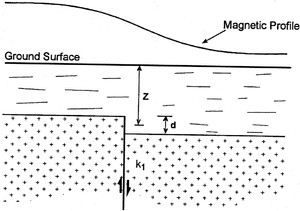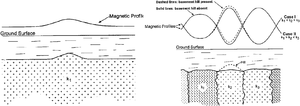Difference between revisions of "Magnetic field: local variations"
(Initial import) |
m (→See also: weird case issue) |
||
| Line 36: | Line 36: | ||
==See also== | ==See also== | ||
| − | * [[Interpreting | + | * [[Interpreting magnetic data]] |
* [[Basement fault blocks and fault block patterns]] | * [[Basement fault blocks and fault block patterns]] | ||
* [[Interpreting residual maps]] | * [[Interpreting residual maps]] | ||
Revision as of 21:35, 17 January 2014
| Exploring for Oil and Gas Traps | |

| |
| Series | Treatise in Petroleum Geology |
|---|---|
| Part | Predicting the occurrence of oil and gas traps |
| Chapter | Using magnetics in petroleum exploration |
| Author | Edward A. Beaumont, S. Parker Gay |
| Link | Web page |
| Store | AAPG Store |
Variations in the local magnetic field are due mainly to the following:
- Lithologic changes of basement rocks with corresponding differences in magnetite content
- Elevation changes on the top of basement where basement is of uniform magnetic susceptibility (k)
However, lithologic changes tend to overwhelm the magnetic response of elevation changes in basement caused by fault throws or basement highs unless basement is deep (> length::5 km, approximately). In this case the slightly magnetic sedimentary rocks begin to show in the magnetic pattern. Most of this is due to detrital magnetite in sandstones.
Elevation change due to a fault
The presence of a fault is a common interpretation of a magnetic increase or decrease. This interpretation assumes the fault throw, which changes the elevation to the top of basement, is the cause of the anomaly. It also assumes uniform lithology and uniform magnetic susceptibility of basement across a fault. Given this (usually incorrect) assumption, we can calculate the depth of the fault and its throw from the shape and amplitude of an observed magnetic curve. If we do not know the exact susceptibility, we can calculate a series of curves to establish a range of probable values of the throw. In all cases, the magnetic high necessarily appears on the upthrown side of the fault.
In the hypothetical cross section below, basement rock has the same susceptibility across the fault.

Detecting basement hills
The basement hill and obvious magnetic anomaly shown on the left side of the figure below assumes a uniform magnetic susceptibility for basement. However, given that basement is usually block faulted, is this type of feature detectable? If we are looking at a topographic prominence centered on a basement block, the detection problem becomes that shown on the right side of the figure. A series of adjacent basement blocks having different magnetic susceptibilities results in a residual magnetic pattern of alternating highs and lows (solid lines).
When the basement block on which the hill is carved is more magnetic than surrounding blocks, the hill contributes slightly to the magnetic high over the block as shown. The slight increase in anomaly amplitude due to the hill (top dashed line) generally is not distinguishable from a similar increase due to a slightly higher magnetic susceptibility for the whole block; hence, the hill is not generally detectable. If the block on which the hill is carved is less magnetic than the adjacent blocks, then the hill results in a lesser amplitude of the magnetic low over that block, but the low is still present (bottom dashed line). The hill generally is not detected.
See also
- Interpreting magnetic data
- Basement fault blocks and fault block patterns
- Interpreting residual maps
- Applying magnetics to petroleum exploration
